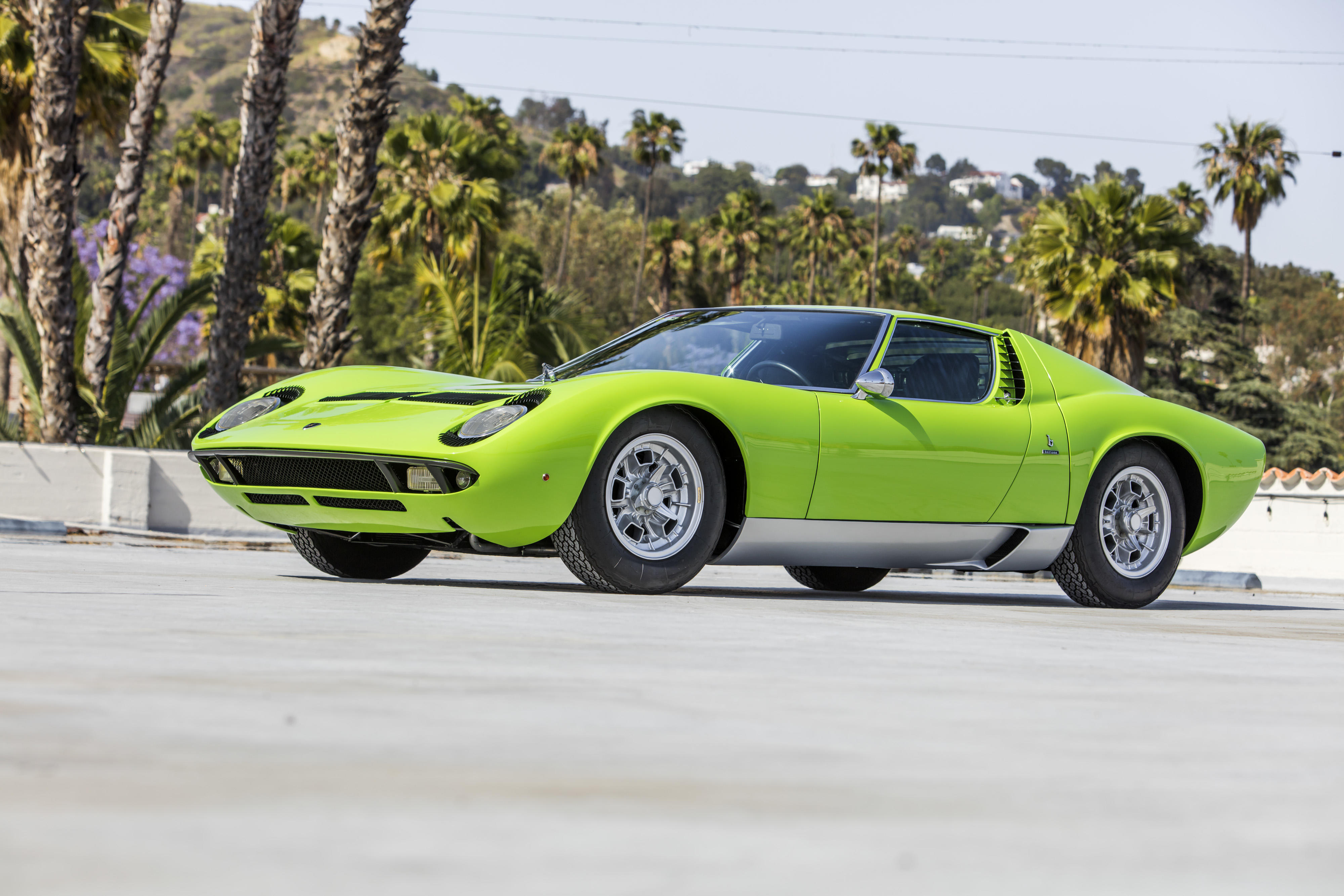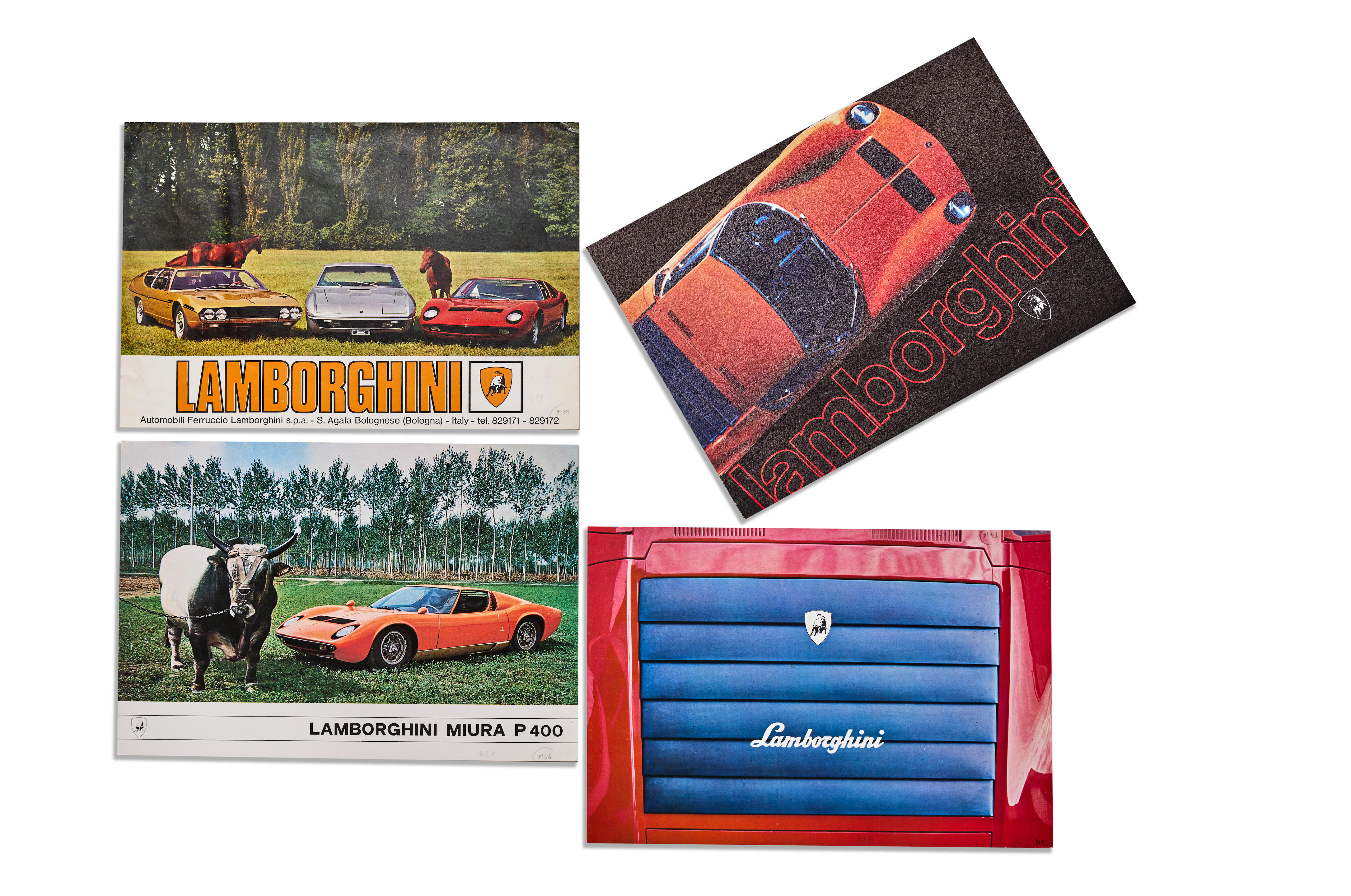3,929cc DOHC All-Alloy V12 Engine 4 Triple-choke Weber Carburetors 350bhp at 7,000rpm 5-Speed Manual Transaxle 4-Wheel Independent Suspension 4-Wheel Disc Brakes *Matching numbers example, retaining its original body panels *One of the desirable and rare Miura S models built *A running and driving Miura, ready for partial or full restoration *Single-family, long-term California ownership THE LAMBORGHINI MIURA One glance at the stunning Miura and you cannot help but think of Rossano Brazzi gliding through the Alpine passes in the opening sequences of the famed British heist movie, The Italian Job. You'll probably find yourself humming Matt Monro's, "On Days Like These," too. From the engine sound, to the voluptuous shape, from the fact that you're seated virtually horizontally in an airplane like cockpit, cocooned in leather ahead of the bullish twelve cylinders, it is an entirely sensory experience to own and to drive a Lamborghini Miura. One that few cars built then, or now, can compete with. Lamborghini's rise in the automobile business to the birth of the Miura was stratospheric. Many automakers started out making bicycles at the turn of the century and had decades of experience in the industry, by contrast this was only the third model that the company built, and the second all new design. Amazingly, its styling prototype was seen less than eighteen months after his first car had debuted. Ferruccio Lamborghini, was the son of grape farmers in the Emilia–Romagna region of Italy, and he must have taken his inspirations from this, beginning his industrial career with building tractors. As this business developed, he later manufactured oil heaters and air conditioning equipment. But in 1963, he took a turn down a new avenue, and formed Automobili Ferruccio Lamborghini SpA to build high-end sports cars. It is said that while he had owned several Ferraris, he felt that he could build a better high-performance car. To do so, he purchased a factory at Sant'Agata Bolognese, near Modena, and hired a cadre of engineering talent. His first production car was the 350GT, launched at the March 1964 Geneva Motor Show. Initially designed by Giotto Bizzarrini, its engine was a four-cam V-12 of 3,464 cc. However, Bizzarrini had designed it as a racing engine, and Lamborghini was adamant about producing a road car. Thus, it fell to Lamborghini's chief engineer Giampaolo Dallara to civilize it for the street. Dallara converted it to wet-sump operation, reduced the compression, revised the cam profiles and changed the racing carburetors to conventional side-draft 40 DCOE Webers. Bodies were made by Touring in Milan, using their Superleggera tubular birdcage technique to mount aluminum panels. Chassis and bodies were mated at Touring, then transported to Lamborghini's facilities at Sant'Agata Bolognese for final assembly. Soon after 350GTs were rolling out of the factory, Lamborghini raised the stakes in the most dramatic fashion at the 1965 Turin Motor Show. It was here that the Miura project was first seen. The world was in raptures over the new design—Lamborghini included—and what some considered to be no more than a styling exercise, he quickly channeled their efforts into and turned into a reality. By the time of the Geneva Salon the following year, the first completed car was ready for unveiling to a stunned press and public. Also designed by Giampaolo Dallara, the Miura carried its transversely mounted engine amidships in a box-section platform chassis, the latter clothed in stunning coupe coachwork styled by Bertone's Marcello Gandini Like the contemporary 400GT, the Miura used the 4.0-liter version of Lamborghini's Giotto Bizzarrini-designed alloy four-cam V12. With 350bhp available, the Miura was capable of shattering performance, a top speed of 180mph being claimed with production examples independently tested at more than 170. Mr. Lamborghini - a bullfight enthusiast - names the car after the iconic Spanish bull, Miura. THE MOTORCAR
3,929cc DOHC All-Alloy V12 Engine 4 Triple-choke Weber Carburetors 350bhp at 7,000rpm 5-Speed Manual Transaxle 4-Wheel Independent Suspension 4-Wheel Disc Brakes *Matching numbers example, retaining its original body panels *One of the desirable and rare Miura S models built *A running and driving Miura, ready for partial or full restoration *Single-family, long-term California ownership THE LAMBORGHINI MIURA One glance at the stunning Miura and you cannot help but think of Rossano Brazzi gliding through the Alpine passes in the opening sequences of the famed British heist movie, The Italian Job. You'll probably find yourself humming Matt Monro's, "On Days Like These," too. From the engine sound, to the voluptuous shape, from the fact that you're seated virtually horizontally in an airplane like cockpit, cocooned in leather ahead of the bullish twelve cylinders, it is an entirely sensory experience to own and to drive a Lamborghini Miura. One that few cars built then, or now, can compete with. Lamborghini's rise in the automobile business to the birth of the Miura was stratospheric. Many automakers started out making bicycles at the turn of the century and had decades of experience in the industry, by contrast this was only the third model that the company built, and the second all new design. Amazingly, its styling prototype was seen less than eighteen months after his first car had debuted. Ferruccio Lamborghini, was the son of grape farmers in the Emilia–Romagna region of Italy, and he must have taken his inspirations from this, beginning his industrial career with building tractors. As this business developed, he later manufactured oil heaters and air conditioning equipment. But in 1963, he took a turn down a new avenue, and formed Automobili Ferruccio Lamborghini SpA to build high-end sports cars. It is said that while he had owned several Ferraris, he felt that he could build a better high-performance car. To do so, he purchased a factory at Sant'Agata Bolognese, near Modena, and hired a cadre of engineering talent. His first production car was the 350GT, launched at the March 1964 Geneva Motor Show. Initially designed by Giotto Bizzarrini, its engine was a four-cam V-12 of 3,464 cc. However, Bizzarrini had designed it as a racing engine, and Lamborghini was adamant about producing a road car. Thus, it fell to Lamborghini's chief engineer Giampaolo Dallara to civilize it for the street. Dallara converted it to wet-sump operation, reduced the compression, revised the cam profiles and changed the racing carburetors to conventional side-draft 40 DCOE Webers. Bodies were made by Touring in Milan, using their Superleggera tubular birdcage technique to mount aluminum panels. Chassis and bodies were mated at Touring, then transported to Lamborghini's facilities at Sant'Agata Bolognese for final assembly. Soon after 350GTs were rolling out of the factory, Lamborghini raised the stakes in the most dramatic fashion at the 1965 Turin Motor Show. It was here that the Miura project was first seen. The world was in raptures over the new design—Lamborghini included—and what some considered to be no more than a styling exercise, he quickly channeled their efforts into and turned into a reality. By the time of the Geneva Salon the following year, the first completed car was ready for unveiling to a stunned press and public. Also designed by Giampaolo Dallara, the Miura carried its transversely mounted engine amidships in a box-section platform chassis, the latter clothed in stunning coupe coachwork styled by Bertone's Marcello Gandini Like the contemporary 400GT, the Miura used the 4.0-liter version of Lamborghini's Giotto Bizzarrini-designed alloy four-cam V12. With 350bhp available, the Miura was capable of shattering performance, a top speed of 180mph being claimed with production examples independently tested at more than 170. Mr. Lamborghini - a bullfight enthusiast - names the car after the iconic Spanish bull, Miura. THE MOTORCAR















Testen Sie LotSearch und seine Premium-Features 7 Tage - ohne Kosten!
Lassen Sie sich automatisch über neue Objekte in kommenden Auktionen benachrichtigen.
Suchauftrag anlegen